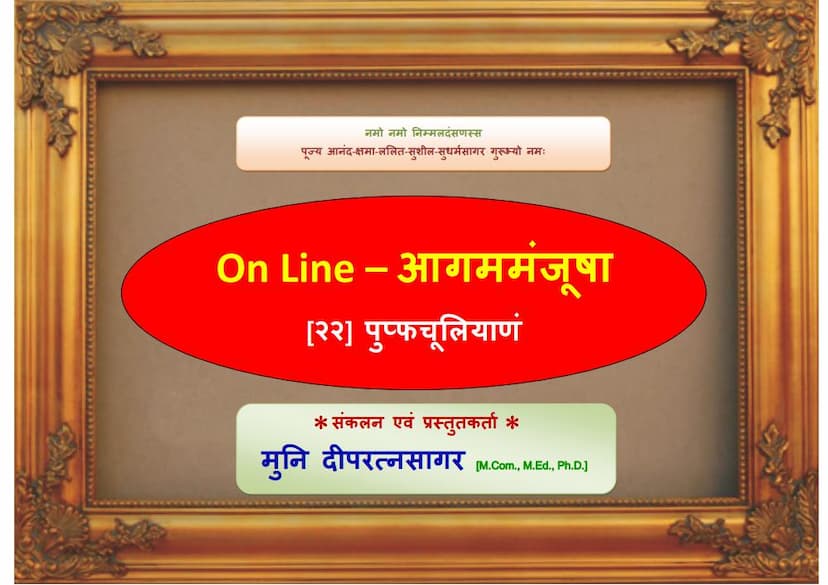Aagam Manjusha 22 Uvangsuttam Mool 11 Pupfchuliya
Added to library: September 1, 2025

Summary
Here's a comprehensive summary of the provided Jain text, "Aagam Manjusha 22 Uvangsuttam Mool 11 Pupfchuliya," based on the provided pages:
This document presents the "Pushpachuliya" (पुष्पचूलिया), which is the eleventh text within the Upangsuttam section of the Agam Manjusha. The Agam Manjusha itself is a compilation of Jain scriptures, and this particular edition is a re-release, updated and made available online after 70 years. The original editing was done by Acharya Anand Sagar Suri.
Key Information and Context:
- Title: Pushpachuliya (पुष्पचूलिया)
- Position in Agam Manjusha: 22nd text in the series, and the 11th Uvang (Uvangsuttam).
- Compiler/Presenter: Muni Deepratnasagar
- Date of Online Presentation: 12/11/2012
- Original Editing: Acharya Anand Sagar Suri (circa 1942)
- Purpose of Online Version: To make the sacred texts accessible through the internet with some beneficial modifications to the original compilation.
Modifications in the Online Agam Manjusha (as noted by Muni Deepratnasagar):
- Aavashyak Sutra (Agam-40): Includes not only the मूल सूत्र (original verses) but also the नियुक्ति (commentary/explanation).
- Jitkalp Sutra (Agam-38): Includes the मूलसूत्र along with the भाष्य (commentary).
- Jitkalp Sutra (Agam-38) - Alternative: The commentary on the alternative scripture "Panchkalp" is also included.
- Oghanuyukti (Agam-41) - Alternative: The alternative scripture "Pindanuyukti" is included, but its printing location has been changed.
- Kalp (Barsa) Sutra: This text has also been included in the original Agam Manjusha.
Summary of the Pushpachuliya Text (Content from Pages 3 & 4):
The core of the provided text is a narrative illustrating the concepts of karma, rebirth, and renunciation within Jainism, specifically focusing on the life of a woman named Bhuta (भूता).
-
The Divine Realm: The story begins by describing the celestial beings in the "Shri Vardhansaka" (श्रीवर्धंनक) celestial abode in the "Soharmakalpa" (सोधर्मकल्प). This sets a context for understanding karmic consequences that can lead to or from such realms.
-
Human Life and Family: The narrative then shifts to the city of Rajagriha (रायगिह). It introduces a wealthy householder named Sudarshana (सुदर्शन) and his wife Somala (सोमाला). They have a virtuous daughter named Bhuta (भूता).
-
Encounter with Mahavir Swami: Lord Mahavir Swami (पासे अरहा पुरिसादाणीए) arrives in Rajagriha and delivers a discourse. Bhuta, along with her family, attends the sermon.
-
Bhuta's Decision to Renounce: Inspired by Mahavir's teachings, Bhuta expresses her desire to join the monastic order. She seeks permission from her parents. Her parents, after initially agreeing, arrange for her to be properly prepared and adorned.
-
Taking Initiation: Bhuta, accompanied by a large retinue, goes to the Samavasarana (the divine assembly) and formally takes initiation (becomes a nun) under Lord Mahavir. She listens intently to the Dharma (religious teachings).
-
The Incident of "Body-Cleansing" (शरीरबाउसिया): After her initiation, Bhuta develops a habit of excessively cleaning her body – washing her hands, head, mouth, and various parts of her body repeatedly. This behavior is described as a form of attachment to the physical self.
-
Disapproval from Senior Nuns: Her behavior is noticed and disapproved of by other senior nuns, particularly Tato Pushpachula (तातो पुष्पचूला). Tato Pushpachula points out that as samanis (nuns), they should not be preoccupied with bodily cleanliness to such an extent and that Bhuta should confess this behavioral fault.
-
Bhuta's Continued Behavior and Consequences: Despite the admonishment, Bhuta continues her excessive cleansing. Because she doesn't confess or rectify this fault, she experiences negative consequences.
-
Rebirth in a Celestial Realm: After her human life, Bhuta dies and is reborn as a celestial being named Shri Devi (श्री देवी) in the Shri Vardhansaka celestial abode in the Soharmakalpa. Her lifespan in this celestial realm is one Palopama (पलिओवम - a vast unit of time).
-
Future Liberation: The text concludes by stating that this Shri Devi will eventually attain liberation (Siddhrihi) in the Mahavideha Kshetra (महाविदेहे वासे) after her current celestial lifespan.
-
General Principle: The text implies a general principle: the story of Bhuta is an example, and similar karmic journeys and rebirths are explained for other individuals (as stated by "एवं सेसाणविनवण्हं भाणियवं" - similarly, the rest should be understood). The nuns who were initially initiated with Bhuta and shared her habit of excessive cleansing will also attain liberation in Mahavideha after leaving their current lives.
In essence, the Pushpachuliya, as presented here, uses the life story of Bhuta to illustrate how even after taking religious vows, subtle attachments and uncorrected behavioral faults can lead to karmic consequences, including rebirths in celestial realms, before eventual liberation. The text emphasizes the importance of introspection, confession, and overcoming all forms of attachment, even to the notion of purity, for true spiritual progress.